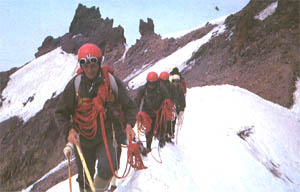Even during the ancient period, the mountains were the holy places for the human beings. Moses received the Ten Commandments on Mount Sinai (Horeb). The Jewish accepts this mountain as the place where Moses also got the first revelation. In ancient Greek mythology, Mount Olympus was accepted as the place for gods. In Anatolia, it was believed that Mount Ida (today named as Mountain Kaz), hosts the gods. We believe in that the effects of religious determinations on the wish of human being to climb to the mountains should not be ignored. Of course the wish to climb cannot be explained only with religious reasons. Actuallycuriosity, adventure and exploring are the main reasons for the human being to climb to the mountains.
The mountains of Cappadocia
Turkey placed on Alps-Himalaya mountain formation zone,this Convolution Mountains divide into two main branches. The first group named as North Anatolia Mountains and lies parallel to Black Sea. The second group lies parallel to Mediterranean Sea, called as South Anatolia Mountains. The entire South Anatolia Mountains are known as Turus Mountains. The Middle Taurus, located in Cappadocia region, formed with two main parts. One of them is Bolkar Mountains, the other is Aa Daglar. Beside these mountains there are two important peaks in Cappadocia. These peaks are not among the certain ridge because they are volcanic peaks. Mount Hasan and Mount Erciyes are the ones which prepared the formation of Cappadocia by exploding lava.
THE TOROS (TAURUS) MOUNTAINS (3756 m.)
The Toros (Taurus) Mountains are the western – most branch of the great mountain chain that stretches across of Asia – the Himalayan mountain belt. The Turkish section of this massive mountain range follows the southern border of Anatolia and is itself made up of four major sections, the Western, Central, Southern and Southeastern Toros (Taurus) ranges. The highest peaks rise out of the Central and Southeastern branches, a stretch of mountains which are rugged, magnificent and arduous to climb.

THE TOROS ALA MOUNTAINS
Forming part of the Central Toros (Taurus) range, the Aladaglar range runs from the southwest to the northeast for approximately 50 kilometers and boasts the region’s highest peak, Demirkazik which stretches to 3756 meters. Other high summits include Kizilkaya in the center (3725 m.) , a peak that reaches 3688 meters in the south, and Mount Vayvay in the east (3565 m.). This long range, situaded in the provinces of Nigde, Kayseri and Adana, rises between Lake Ecemis and Zamanti River.
The geology of the area is responsible for the interesting rock formations and waterfalls. The erosion of limestone has created a fascinating karstic topography and hydrography, especially in the Yedigöller valley, where karstic underground river and caverns collect the surface water. Both the Mediterranean and Anatolian weather systems influance the climate of the Aladaglar bringing warm summers and cool winters to the mountains.
Trips and Climbs The best season to climb the mountains is during May, June, July and August when the alpine meadows of the higher elevations are rich in vegetation.
Researces and mountaineers ascending the Aladaglar usually begin their climb from either Camardi or Cukurbag villages. Those attempting to climb the demirkazik summit depart from Demirkazik village. Both of these villages lie 65 km from Nigde and can be reached by asphalt road.
Regional Attractions The yaylas of the Toros (Taurus) Aladag are the summer homes of entire villages and the summer grazing of herds of animals. Be sure to see the rounding up of all the animals for milking. Traditionally women of these encampments have produced some of Turkey’s most beautiful carpets and kilims, and it is often possible to see a carpet still in progresis.
MOUNT ERCIYES
One of the Turkey’s most important mounteering and winter sports centers. Mount Erciyes rises from the south of the Kayseri valley. The Sultan Marses lie to its west and to the south falls the Develi valley. Its summit always covered in snow and ice. Mount Erciyes ranks as Central Anatolia‘s tallest volcano.

Approximately 18 kilometers in diameter and covering an area of 1000 square kilometers, the mountain’s stratification and geology make it a fascinating geographical formation. The region’s climate, influenced by that of the Anatolian plateau, is considered typical of steppe geograpy. Certainly the winter brings considerable snowfall to the higher elevations. The northern side of the mountain enjoys a somewhat more temperate climate encouraging the cultivation of vast areas of vine and fruit orchards between 1100 and 1600 meters. Above that altitude, vast meadows stretch far into the distance. The higher elevations display typical alpine vegetation. Herds of animals graze year round on the east, north and west slopes of the mountain.
Trips and Climbs Mountaineers attempt Mount Erciyes either on the northwestern flank or from the south and find the best climbing in June, July, August and September.
Regional Attractions Tourists visitng the area should also see the fantastic rock formations, underground cities and fabulous frescoes in rock carved churces in neighboring Cappadocia. The Sultan Marses, a habitat for many different species of birds, has fortunately been designated a National Park and wildlife preserve.




